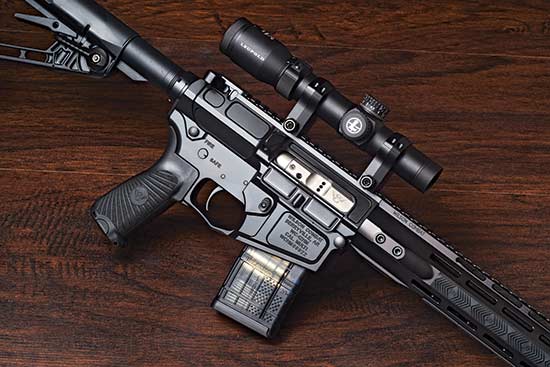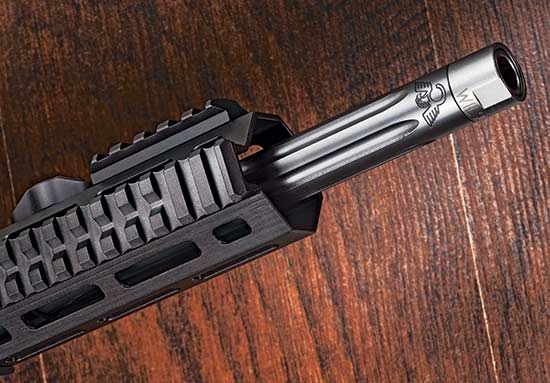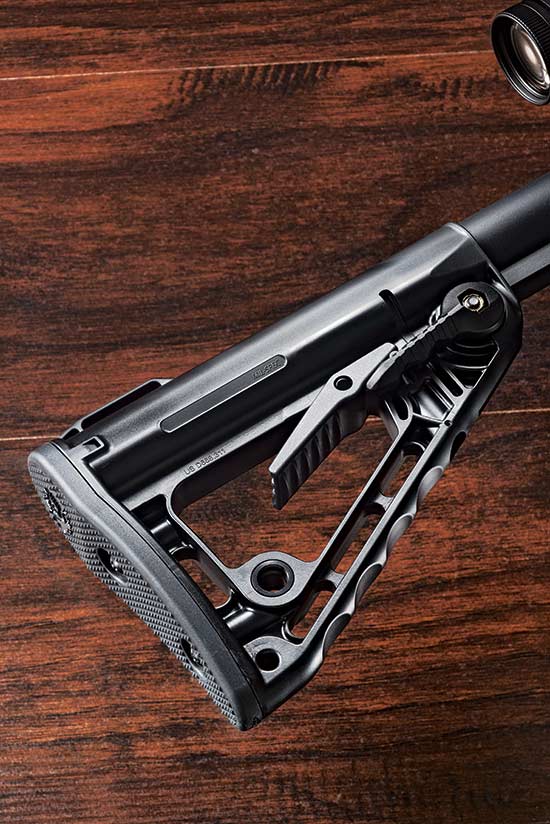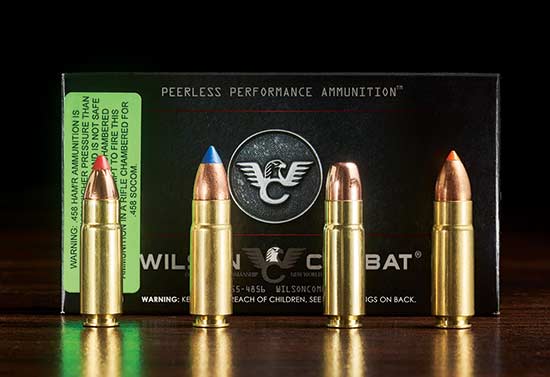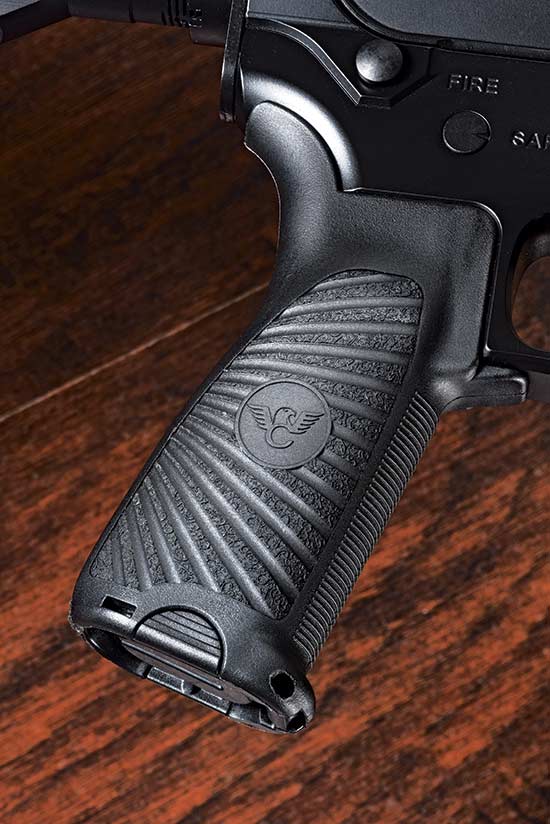Arma-Hevi?
Wilson Combat's .458 Ham'r Hits Like A Flying Anvil
Billed to be the “most powerful (practical size) AR platform carbine ever produced, exceeding the ballistics of the .450 Bushmaster, .458 SOCOM and .500 Beowulf,” Wilson Combat’s introduction of the .458 HAM’R combines a big-bore proprietary cartridge with a newly designed AR platform the Wilson crew likes to describe as an “AR-12.”
Innovations like these drive the firearms industry, and when a company like Wilson Combat, revered for its custom 1911s, both develops a new cartridge and then builds a radically new platform around it, it’s sure to whip up some attention. It sure got mine. I’m ready for an AR-African safari.
A Case For The Cartridge
Looking over existing case designs, Wilson was intrigued by the .458 SOCOM. Named after the Special Operations Command by its originator, Marty ter Weeme of Teppo Jutsu LLC in the year 2000, the SOCOM is a short, fat, capacious case with a rebated rim, generous neck and designed to fit and feed from existing AR-15 magazines and M4 lowers.
Taking the basic SOCOM case, Wilson pushed the shoulder forward 0.030″ while maintaining the same shoulder angle. The results were twofold. Pushing the shoulder forward increased the case capacity, permitting more powder to be loaded, resulting in slightly higher velocities when compared to the SOCOM. Think of the resulting HAM’R as an “improved” case. More powder also increased working pressures in the range of 46,000 psi, which necessitated designing a new and stronger action.
The second effect of moving the shoulder forward was to prevent some naïve shooter from loading the higher pressure .458 HAM’R round in a .458 SOCOM AR. The difference between the two cases is extremely subtle. Unless you have micrometers for eyeballs, I doubt you’d sense any difference, except for two different headstamps. I sure couldn’t. I suppose you might be able to load a HAM’R in a SOCOM AR, but it would require hammering the back end of the bolt carrier group — or repeatedly slamming the bolt home. Not likely? No, but you’d be amazed what people do.
On the plus side of just moving the shoulder slightly forward is handloaders can use a standard set of .458 SOCOM dies to load the .458 HAM’R. It’s simply a matter of backing off the sizing die to establish proper headspace without pushing the shoulder back to SOCOM land. What would really be helpful to handloaders would be a case headspace gauge to set up the sizing die. Maybe Bill Wilson will hear my plea and get cracking.
Anyway, Starline Brass is drawing the HAM’R brass with a small rifle primer pocket. It’s nicely headstamped “458 HAM’R” and competitively priced. (Psst — they also just did a run of .455 Webley MK11 brass. Get it while it lasts.)
An Action All Its Own
To handle this high-pressure beast, Wilson machined from aluminum billets a completely new AR-10-type upper and lower. They call the resulting AR a “hybrid” and indeed it is. Think of it as a slightly shrunk-down AR-10 action with an AR-15 dimensioned magazine well accepting modified Lancer AR-15 magazines holding 7 or 9 rounds of .458 HAM’R.
The bolt is an AR-10 bolt, but the whole bolt carrier group is 3/4″ shorter than normal. It’s also plated with Robar’s remarkable NP3, ensuring permanent lubricity and ease of cleaning. Now that Wilson Combat has a hybrid AR-10/AR-15, my hunch is we may be seeing a number of new cartridges introduced in the platform. Wouldn’t a 338 or 375 HAM’R be the Hammer-of-Thor on most North American big game? Yes!
Combined Components
Having the heart and soul of the HAM’R machined out, the fun part begins, selecting and fitting the components to produce the Tactical Hunter Model pictured here. Since Wilson Combat already offers four different AR platforms in 22 calibers, this job proved to be duck soup for them.
To flesh out the HAM’R platform, Wilson added one of their 18″ fluted, match-grade barrels fitted with a mid-length gas system, an SLR Rifleworks adjustable gas block, and threaded 11/16 x 24 at the muzzle. The stock setup consists of a Wilson Combat 14.6″ M-Lok handguard with a continuous Picatinny top rail and short side rail padded out with three Falcon/Ergo rail covers. The buttstock is a 6-position Wilson/Rogers Super-Stoc mated with a Wilson Combat/BCM Starburst Gunfighter grip.
My favorite Wilson Combat component though was their 4-lb., 2-stage TTU match trigger. It’s light, crisp and proved invaluable while tweaking out all the accuracy the rifle had to offer at the range.
Finished in Armor-Tuff, the Tactical Hunter weighs 7 lbs. 11 oz. with an adjustable overall length of 34.25″ to 37.5″.
For optics, our test rifle came factory mounted with a Leupold 1.25-4×20 VX.R Patrol scope, featuring a Fire Dot illuminated crosshair within a circle and Motion Sensor Technology, which dampens down the intensity of the Fire Dot if the rifle is not being moved. It’s the perfect scope for a short-range, big-bore cartridge, offering fast target acquisition and a calibrated reticle for more precise shot placement at longer ranges.
Clocking And Grouping
To feed the Tactical Hunter, Wilson Combat currently offers four factory loads — a 250-gr. Hornady MFX, a 300-gr. Nosler BT, a 300-gr. X-Treme RNFP and a Barnes 300-gr. TTSX. Shooting 3-round groups at 100 yards, I found the most consistently accurate loads to be the Hornady 250 MFX (0.52″–1.05″) and the Nosler 300 BT (0.65″-1.28″).
On the other hand, based on my experience from the standpoint of performance on game, I was drawn to the Barnes 300-gr. TTSX at 2,100 fps. This is the load providing all the velocity and power the cartridge was designed to deliver. It’s no slouch in the accuracy department either, producing groups ranging from 1.25″ to 1.44″.
With an optimum zero of 125 yards, the Barnes TTSX is +0.9″ at 100 yards, -1.6″ at 150 yards, -4.0″ at 175 yards and -7.3″ at 200 yards. And it’s powerful. At the muzzle the TTSX is churning up 2,938 ft-lbs., while at 175 yards it’s still delivering 1,639. I’d call the HAM’R a good 100- to 175-yard hunting round. And given trajectory considerations, I’d be happier keeping my shots under 150 yards.
Recoil? No more than an AR-10 chambered in .308 Win. The gas system and the weight of the Tactical Hunter really soak it up.
While I didn’t have a suppressor to fit, the .458 HAM’R would be a devastating round at subsonic velocities. In fact, the original SOCOM cartridge was widely promoted as a suppressed round to take out sentries and stop vehicles and personnel at checkpoints. The HAM’R could fill that role to a T.
Wilson Combat currently offers the Tactical Hunter ($2,905) and a second model, the Ultimate Hunter ($3,055), featuring a fixed, lightweight, carbon stock in place of the 6-position stock on the Tactical Hunter.
Big-bore ARs are a real hoot to shoot. The big boomers have a unique appeal all of their own. It’s neat to see Wilson Combat expanding their offerings with a totally new AR platform and a real HAM’R of a cartridge.”
Hogs, watch out!


